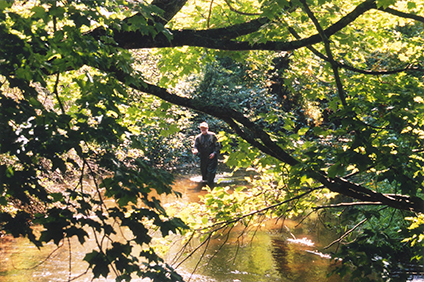High Population Brown Trout Streams Lack Big Trout

Retired DNR fish biologist Roger Kerr has definite ideas on improving trout fishing in southwest Wisconsin streams.
by Roger A. Kerr
Retired Fish Manger
Back in the late 1970s Pennsylvania State University PhD student Robert Bachman conducted a brown trout study that had never been done before. He spent thousands of hours watching brown trout go about their daily business making a living in Spruce Creek in central Pennsylvania. This was (is) a food rich limestone stream with no-kill rules and a very high population of wild brown trout. He also conducted occasional shocker surveys to obtain data on actual trout numbers in his study area, ages of the trout and their size.
Two of his most important findings were that the trout spend most of their time right in the open at feeding sites and that none of the trout grew to 20 inches even with no harvest allowed and a food rich environment. A third important finding was that the population of Age 1 and older trout was almost 4,000 per mile. (A follow up study of this trout population showed that natural mortality killed about 1,800 of these 5’’ to 15” fish per mile per year.)
Some of the trout in his study area were there for the 3 years that he observed them. Older trout only grew about an inch per year. This slow growth was the reason there were no big trout in Spruce Creek. Older trout did not get enough food to grow to 20 inches. No-kill did not produce large trout in Spruce Creek and fish over 15” were rare.
Here in Wisconsin a study of Timber Coulee Creek brown trout in Vernon County by Wisconsin DNR trout researcher Matt Mitro showed similar results. Trout over 14 inches in a no-kill area in this stream declined after it was made no-kill in 2003. There were no 20-inch trout in this section despite it being no-kill and a food rich limestone stream.
The most recent study of slow growing adult brown trout was conducted in Spearfish Creek in South Dakota in 2016 and 2017.The biomass (poundage) of adult brown trout in this stream was about 3 times larger than in similar streams in South Dakota yet the average length of adult fish was 30% less than in the lower population streams. Trout researchers wanted to see if trout removal would improve the growth of the remaining adult fish. Control sections were created where there was no removal of trout. This allowed for trout growth to be determined in the removal areas and the no removal areas to see if removal improved growth.
Harvest was allowed in Spearfish Creek but a creel survey conducted on this stream in 2010 showed that most anglers who fished this stream did not kill and eat the trout they caught. This was partially why the poundage of trout in this stream was 3 times greater that the poundage in other area streams.
Trout growth in the removal areas was better than in the control areas. So, clearly, the abundance of trout in Spearfish Creek reduced their growth rate. But, as with the brown trout populations in Spruce Creek and Timber Coulee Creek, there were no 20-inch trout in Spearfish Creek and trout over 15 inches were rare.
This South Dakota study was published in the North American Journal of Fisheries Management, Volume 40, Issue 6 in 2020.
MANAGEMENT IMPLICATIONS FOR THESE STUDIES HERE IN WISCONSIN
It is very clear that the Wisconsin DNR has adopted the Trout Unlimited policy that trout should be a sport fish and not a food fish. In 1949, the bag limit for trout was reduced from 15 to 10. A few years ago, the bag limit was reduced from 10 to 5.
In 1990, trout rules in Wisconsin went from a few words to 32 pages for the purpose of reducing harvest and improving trout fishing. This resulted in a dramatic decline in trout harvest and trout fishing activity.
There is no evidence that trout fishing now in Wisconsin is any better than it was 20 or 30 or 40 years ago despite all the effort the Wisconsin DNR has made to make it better. Brown trout do not respond to special protective rules because anglers can’t kill more brown trout than would otherwise die of natural causes anyway.
The Wisconsin DNR trout management program really has been a trout mismanagement program for the past 31 years.
If I were made Wisconsin Trout Czar, I would restore the 10-bag limit, terminate 95% of the current 400 special trout rules and begin the harvest season on the first Saturday in March.
Footnote: The mismanagement of the Wisconsin trout resource since 1990 can be easily demonstrated. Around 800 of the special rules created in 1990 to improve trout populations have been terminated because they did not improve trout populations. Trout anglers had to abide by these rules when they were in effect. I would be interested in knowing how many citations were issued by wardens to anglers for violating rules that proved to be worthless.











